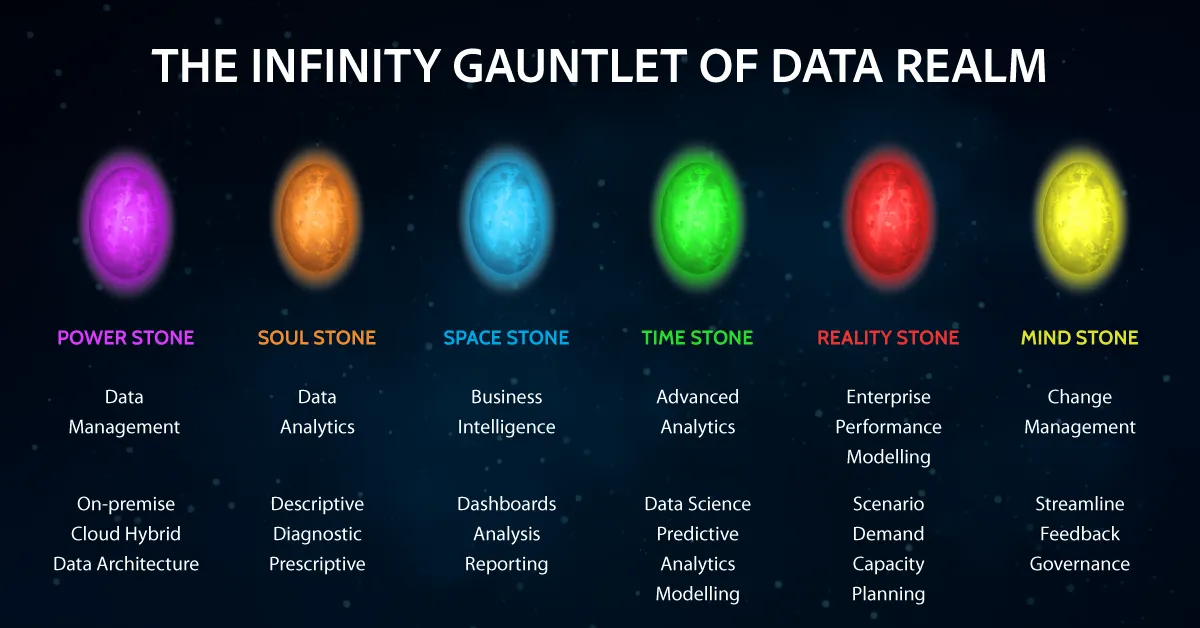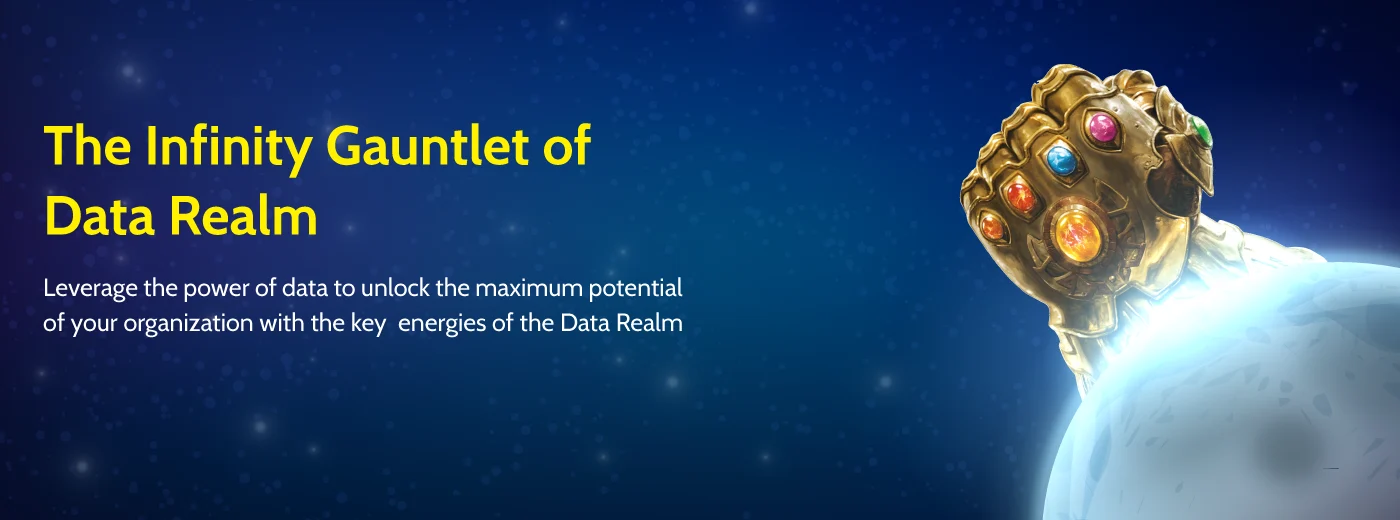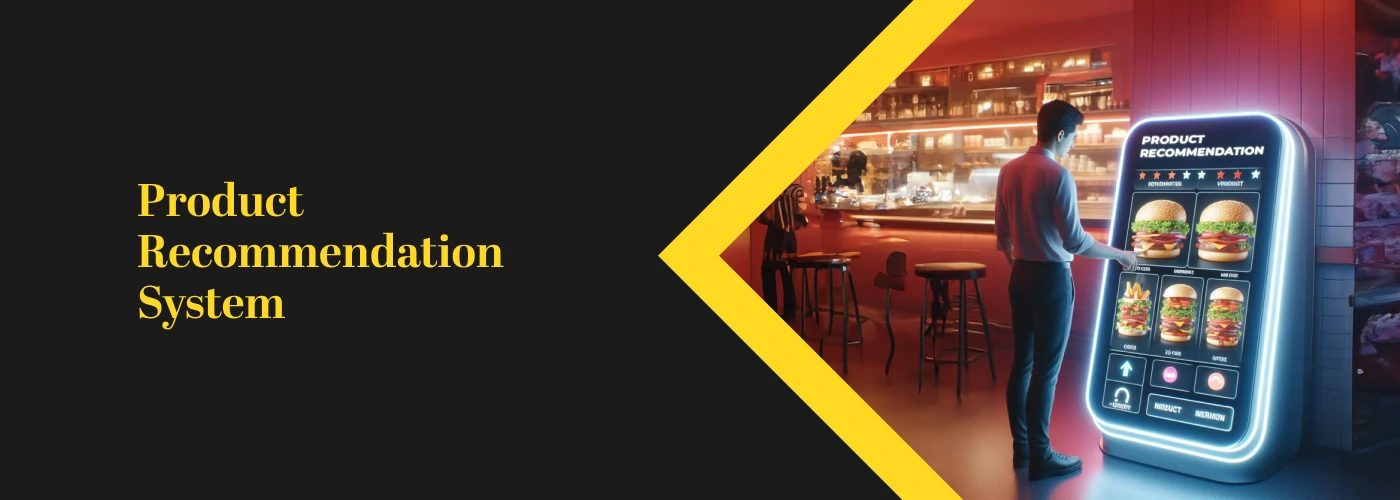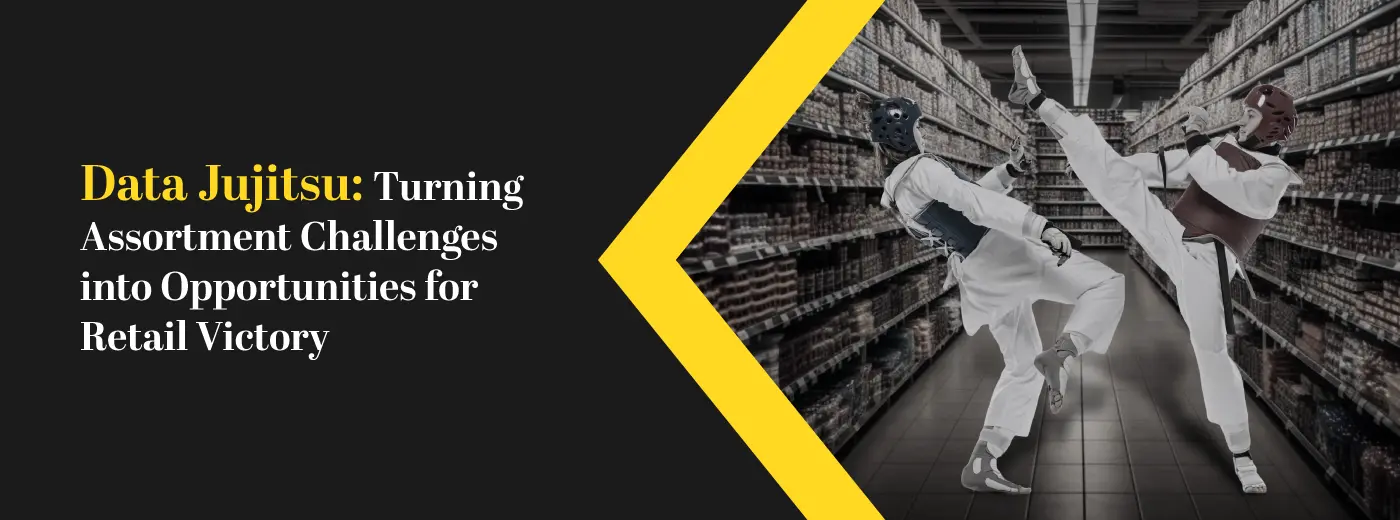We love data 3000.
With the release of the recent installment of Marvel’s Spiderman and the New Year’s “retrospection” ongoing, we’ve also been contemplating how powerful Data has been and what better way to explain than with the Infinity Gauntlet. So, brace yourselves for a Marvel-Esque ride into the realm of Data.
The Blip
| “I am inevitable” - Thanos
Don’t misunderstand us. We’re not talking about Thanos coming to threaten the data of your organization with a “Snap”. But, what is inevitable? We’d say it is the desire of every organization to be data-driven.
With the Infinity stones of Data, we intend to show you the same - how to be powerful enough as a data-driven organization, to have powerful control over all the aspects of your organization to streamline decision making.
"Research shows that data-driven organizations are 162% more likely to significantly surpass revenue goals than their laggard counterparts."
But what do you need? This is a complicated question that can only be answered after knowing things like the organization’s current infrastructure, analytics requirements, future plans, and much more. But for now let’s stick to a few topics, which, similar to the Infinity stones, represents one function, which in itself is powerful as a stand-alone. But combining one with the other would give the user the maximum potential out of them.
Power Stone
| The Power Stone bestows upon its holder a lot of energy—the sort of energy that you could use to destroy an entire planet.
That’s a lot of energy. But let’s break it down to the foundation. How do we find the energy at its raw source? Since we’re not talking about “energy”, but data here, how to find the data and leverage its power.
For us, it is the Data Management and Infrastructure that form the foundation of Data energy. It is what gives data the power and the ability to be used. With choices like On-premise, Cloud, and Hybrid Data Storage along with the choice to have a Data Warehouse or Data Lake or both, there is always a lot to think about and question yourself before gaining the strength.
To do this, you’ll have to understand the benefits of Data Warehouse as a service, think about having a unified data warehouse and data lake architecture, or leverage DevOps capabilities. But before that you might need to consider:
- How is the data going to be utilized?
- Would you be planning for Data Science capabilities?
- What is the existing infrastructure based on in the organization?
- Defining the vision and value of Data Governance
- Charting out the stakeholders and the responsibilities
Soul Stone
| “Soul holds a special place among the Infinity Stones. You might say it has certain wisdom” - Red Skull to Thanos
What is the soul of an organization? Some would say the data, some would say the people, some would say the values. But for a “data-driven” organization, the soul would be the data, as the entire process of deciding what data to capture, what data to utilize, how to store it, and deciding how to utilize it revolves around data.
And the first step in this journey, which is our Soul Stone, is Data Analytics (after deciding on the Data Infrastructure i.e. a Data Warehouse or Lake). This step involves deciding on which type and stage of analytics the organization would be of Descriptive, Diagnostic, Predictive, Prescriptive, and Cognitive Analytics.
Most Analytics use cases are specific to an industry, so I wouldn’t go into it. But broadly speaking you can use the past data to find actionable insights, use the data to improve processes, or even identify sources of revenue or cost centers. Therefore, before getting into Data Analytics, you might need to think of:
- What are the problems you are looking to solve?
- Are your employees trained to handle the change or the platforms?
- Have you formulated the SOP or the process for implementing data analytics?
- What is the technology that is being used and how did you arrive at it?
Space Stone
| “The cube is a doorway to the other end of space.” - Hawkeye
Space stone gives the user power over space. In reality, for an organization what would the space be? The multiple hierarchies or the divisions or the business units or even the multiple product SKUs? Whatever you choose it to be, there is a tool that enables you to break down the data into layers and also view it as a single consolidated report. No surprises here, it is Business Intelligence.
With the right BI Implementation, you give the users the ability to create a doorway between the data and the user in a manner understandable by everyone. Self-Service BI with interactive dashboards, reporting, and analysis processes makes it easy for even non-data users.
Business Intelligence is useful to have a streamlined reporting mechanism, which lets the users decide on the levels of sharing the reports and the security of sharing the data making governance easier too. Some of the questions to consider before deciding on the right BI tool for your organization would be:
- How many different data sources are to be integrated for analysis?
- Would you need the platform to offer public, private, hybrid cloud, or on-premise accessibility?
- Does it come with in-built AI & ML capabilities or does it require to be implemented separately?
- What public and documented APIs are available for customizing and integrating applications?
Time Stone
| The Time Stone grants its owner the power to rewind or fast-forward time.
Time- it’s a tricky concept isn’t it. Not going into the physics of it but it is a hard concept to manipulate and think about. But there are multiple ways to look at it from a data point of view. One can be the computational power of the algorithms you write and deciding on which algorithm would be better suited for the data like Logistic regression vs Random Forest etc., which would fall under the area of Data Science or Advanced Analytics.
Another similar concept would be Predictive analytics. It is using historical data to make predictions about the future by using statistical modeling, machine learning, and data mining. Some of the examples in this would be fraud prediction, churn prediction with employees, identifying product recommendations, etc.
Even though the use cases can be industry-specific, one common requirement irrespective of the industry is having the capabilities i.e. Data Lake infrastructure, Data scientists, specific software requirements, etc. before the Advanced Analytics implementation. Some of the few things to think about wrt Data Science capabilities are:
- Do you need any additional infrastructure and data requirements in addition to the existing ones?
- What level of ML & AI capabilities are required?
- Do you require NLP or NLU understanding?
- Are you basing your Analysis based on open-source software or licensed? Do your users have the capability to work on them?
Reality Stone
| "Reality is often disappointing. That is, it was. Now, reality can be whatever I want." - Thanos
Technically, Reality is not always disappointing. But sometimes, it just means you’re under-prepared. But how can you understand the multiple possibilities and plan for them? Demand Planning, Capacity Planning, etc. can be done but how can you be sure that the reality would be as planned, this is where Scenario Planning comes into the picture.
As such a planning platform, like Anaplan can make viewing multiple scenarios in a single view possible. What you can do is look at all the possibilities and choose a reality best suited for you. It can also help you integrate multiple sources of information with its integrators, APIs, and connectors.
The best part is that they can be personalized and designed as per your organization’s hierarchy or data requirements and multiple scenarios can be planned accordingly. A few things to consider while thinking about an EPM like Anaplan are:
- What are the data points that have to be integrated? What should be the rate of data refresh?
- Do you want to have multiple projects integrated under multiple Business units?
- What are the key parameters you are looking to keep an eye on?
- What levels of hierarchy do you want to have in the decision-making process?
Mind Stone
| The Mind Stone. It's one of the six Infinity Stones, the greatest power in the universe, unparalleled in its destructive capabilities. - Thor
Mind is complicated and more often than not underrepresented. This is what we want to talk about with the Mind stone- Understanding the “Minds” of the organization. A roadmap for any of the above-mentioned services can be made, presented, and explained. But what is it that is the most important? The implementation and Change Management.
Making the insights generated into something actionable and getting people to work on them is the actual task. One of the reasons why Enterprises fail with their initiatives is lack of user adoption i.e. not upskilling or reskilling to suit the changing initiatives and also lack of executive-buy in.
Therefore before the whole process of the implementation, talk to the people and make sure they are ok with the change. Otherwise, people would revert back to their old reporting or analyzing processes leaving the whole implementation to waste. Some key issues to keep in mind are:
- What is the level of training needed for users to implement the new technology?
- What is the governance mechanism in place to ensure a streamlined implementation?
- Does the implementation have a feedback loop in the mechanism?

In Conclusion
Snap Away!
Combine the power of multiple stones to be the - Data-driven organization, or use the power of one to master an element. Just don’t underestimate the Power of Data.
Disclaimer: All comic personalities and the ideas mentioned herein, and related images used, are the sole and exclusive property of Marvel Comics. Some of the references used were from Marvel Cinematic Universe and this time article.



